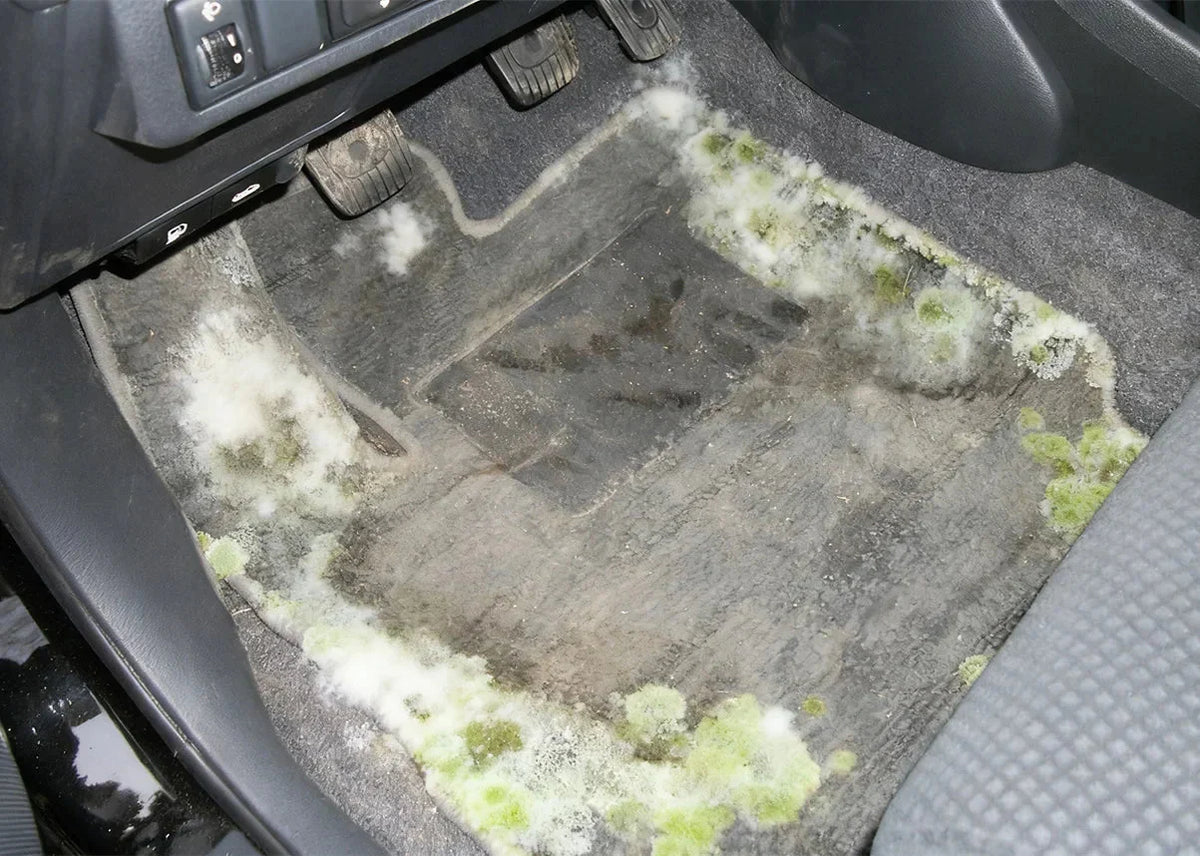

If you ever find mold growing in your car, you know it is not a pleasant surprise. The smell is strong and the sight is not good either. You may be asking yourself how to get mold out of your car and make it fresh again. Mold in cars is a common issue, especially where the weather is damp, but you do not need to worry, you can fix it if you act soon. Taking care of the problem quickly helps protect your health and your car's inside surfaces.
Use this guide to learn simple steps that help you clean out mold and keep it away for good.
Table of contents
The Dangers of Mold in Your Car
Mold brings more trouble than just a bad smell or an ugly patch on the seat. It can actually harm you and your car which is why you should take it seriously.
Danger |
Description |
Health Risks |
Mold spores can cause allergic reactions, respiratory issues and asthma attacks. |
Unpleasant Odors |
A persistent musty smell can make your car unpleasant to be in. |
Interior Damage |
Mold can stain and degrade your car's carpet, seats and other surfaces. |
Poor Air Quality |
Spores can circulate through the HVAC system, contaminating the air you breathe. |
Lower Resale Value |
Evidence of mold can significantly decrease the market value of your vehicle. |
How to Identify Mold in Your Car: Key Signs and Symptoms
A Persistent Musty Odor
If you notice a damp, musty scent that does not fade, even after cleaning and airing out, it could be mold. This smell often gets stronger if your car is closed for a while.
Visible Growth or Stains
Check your car's carpet, seats, floor mats and even under the seats. Mold can look fuzzy and come in colors like black, green or white. Tiny spots or patches could be a sign of bigger problems.
Increased Allergy Symptoms
If you or passengers get sneezy or have watery eyes only when riding in the car, mold might be the reason. More allergy problems in the car than outside is a big clue.
Condensation on Windows
Lots of water drops or fog on the inside of your car windows mean extra moisture in the air which helps mold grow more quickly.
Damp Carpets or Upholstery
Check if any part of your car's carpet or seat feels damp. Moist spots or areas that never seem to dry out are places where mold can start.
Essential Safety Precautions Before Starting
Before you begin to clean, you should make sure you keep yourself safe from mold. Wearing the right gear and following easy safety steps helps you avoid breathing in spores or spreading them around.
Wear Protective Gear
Rubber gloves keep your hands safe from mold and cleaners. A face mask, especially an N95, helps you avoid breathing in the tiny spores.
Work in a Well-Ventilated Area
Take your car outside and open all the doors and windows. This keeps fresh air moving and keeps mold spores and chemical smells from building up around you.
Protect Your Eyes
Goggles can stop both spores and splashes from getting in your eyes, making sure you do not get an infection or irritation.
Disable the HVAC System
Before cleaning, turn off your car's heater and air conditioning. This keeps spores from being pulled into the system or blown through the vents.
Keep Children and Pets Away
Mold and cleaning products are not safe for kids or pets. Make sure they stay out of the workspace and away from your car until the cleaning is done.
How to Get Mold Out of Car Carpet and Upholstery?
You want to make sure your car's seats and carpet are not just clean on the surface, but deep down too.
Vacuum Thoroughly: Use a vacuum with a HEPA filter to clean the whole inside. Be sure to go over every area, including the carpets, seats and mats. The HEPA filter will trap small spores so they do not get into the air.
Choose Your Cleaning Solution: Pick a commercial mold remover or use a simple mix of vinegar and water. Sometimes, tough stains do best with a carpet cleaner. To be safe, try your cleaner on a small, hidden area to make sure it will not damage anything.
Scrub the Affected Areas: Spray or dab the cleaning solution on the moldy spots. Wait a few minutes, then scrub using a stiff brush so the mold lifts out of the fabric.
Rinse and Blot the Area: Use a clean, damp cloth to gently wipe off the solution and any loose mold. Try not to use too much water. Blot up as much moisture as you can with dry towels.
Dry the Interior Completely: Make sure no wetness is left behind. Use fans, a dehumidifier or a hairdryer on low to make everything dry. If you can, leave your car out in the sun with the windows open for a few hours.
How to Get Mold Smell Out of Your Car for Good?
When you finish cleaning, you may still notice the musty smell. That lingering odor usually means there is still some moisture or small patches of mold left.
Use Baking Soda: Sprinkle baking soda over the seats and carpet. After letting it sit for several hours (or overnight), vacuum carefully. Baking soda pulls smells out of fabric naturally.
Try Activated Charcoal: Place small bags of activated charcoal under the seats or in the trunk. Charcoal absorbs smells from the air without making a mess.
Let the Sunshine In: On sunny days, open your car doors and windows. Sunlight and fresh air help kill remaining mold and clear out any leftover smell.
Clean the HVAC System: If the odor is coming from your vents, use a disinfectant spray made for car HVAC systems. Spray it into the vent openings so the freshened air flows through every part of the system.
Find and Fix Leaks: Check your car for leaks like around windows and door seals and repair them. Stopping leaks is key because mold will return if water keeps getting in.
When to Call a Professional?
While you can take care of most mold problems yourself, there are times when it is better to let an expert do the job. This keeps you safe and makes sure every last bit of mold is gone.
The Mold Infestation is Widespread: If mold covers a lot of seats, carpets, or other big areas, you may need stronger cleaners and special tools than what you have at home.
The Mold Returns After Cleaning: When cleaning doesn't work and mold comes back, there might be a bigger problem that only a pro can find and fix.
You Have Health Concerns: If you or your family have allergies, asthma or weak immune systems, cleaning mold can be risky for you. It is safer to have a professional take care of the job.
Mold is Inside the HVAC System: If mold is deep inside the vents and ducts, professionals can take apart and clean the whole HVAC system to make sure the air you breathe is safe.
Strong, Persistent Odors Remain: Sometimes, even after your best efforts, the smell will not go away. Experts can use special treatments like ozone cleaning, to get rid of stubborn smells.
How to Prevent Mold?
Once you put in the hard work to clean mold out of your car, you will want to keep it from coming back. The best way to do this is to control moisture and develop a few easy habits that keep your car dry.
Fix Water Leaks Promptly: Check your car's door seals, windows, and sunroof for leaks often. Fix them quickly to keep water and dampness out.
Clean Up Spills Immediately: Whenever something spills in the car, use towels to soak it up right away and make sure the area dries completely.
Use Moisture Absorbers: Place products like silica gel packets or small moisture-absorbing boxes inside your car. They are simple but work very well in controlling humidity.
Ensure Proper Ventilation: On dry days, crack open your windows for a bit to let air move around your car and let out any trapped dampness.
Invest in Quality Floor Mats: High-quality, waterproof floor mats like 3W Liners help trap water, mud, and snow. They are easy to take out and clean, which helps you keep the floor underneath dry.
Quick Daily Habits to Reduce Moisture
You do not need to do a lot of work every day to keep your car dry. Some quick habits like knocking snow and water off your shoes before you get in or cleaning up wet clothes or towels right away, can really help prevent moisture from building up.
Checklist for Mold Prevention
This list will help you remember what steps to take to stop mold from coming back and keep your car smelling fresh.
- Check for and repair any water leaks from windows or doors.
- Clean up spills as soon as they happen.
- Avoid leaving wet items inside your car.
- Air out your car regularly on dry, sunny days.
- Use moisture absorbers if you live in a damp climate.
- Regularly clean and dry your floor mats.
- Upgrade to 3W Liners all-weather floor mats to protect your car's carpet.
Conclusion
It is possible to get rid of mold and stop it from coming back if you know what to do and act quickly. By cleaning up as soon as you see mold and handling any moisture problems, you protect both your health and your car. Regular cleaning, fixing leaks and drying out spills will keep you safe from future mold. For extra peace of mind, try custom-fit floor mats such as 3W Liners to block out water and keep your car's carpet fresh, clean and mold-free for years.
For more tips on keeping your car interior clean, especially detailed instructions on maintaining your floor mats, check out our guide on how to clean car floor mats.
FAQs
1. Is mold in a car toxic?
Yes, mold in a car can be toxic. It releases spores that may trigger allergies, respiratory issues, and irritation. Prolonged exposure, especially in confined spaces like a car, can affect health, so removing mold promptly is important.
2. What kills mold instantly in a car?
Strong disinfectants, like isopropyl alcohol or commercial mold removers, can kill mold instantly in a car. Steam cleaning is also highly effective on fabric surfaces. Always follow safety precautions and ensure the area dries thoroughly to prevent regrowth.
3. How can I prevent mold from returning in my car?
Prevent mold by controlling moisture. Fix leaks, clean spills immediately, use moisture absorbers, ventilate your car regularly, and use waterproof floor mats like 3W Liners. Keeping surfaces dry and clean is the most effective long-term prevention.



